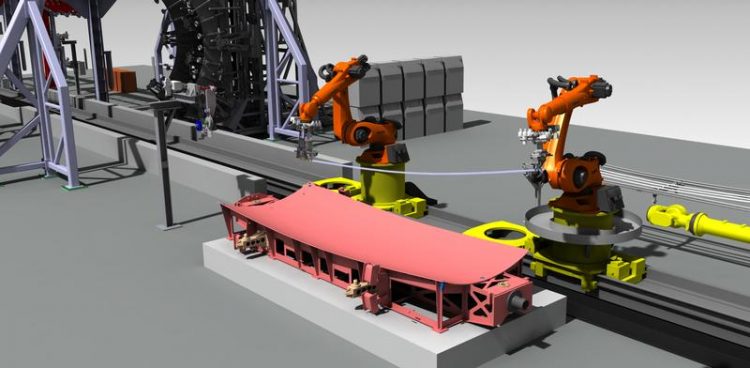Analog and digital – Automated manufacture and machining of fiber reinforced plastics

Virtual test run of the process chain for stringer integration into an aircraft fuselage by offline programming of the motion paths of the robots © Fraunhofer IFAM
Enhanced production efficiency by creating a digital twin of the real plants
Digitalization opens up a host of new opportunities for increasing the production efficiency in various industries. Many processing steps can be optimized using simulation, leading to enhanced productivity, shorter commissioning times, and ultimately cost savings.
The prerequisite for this is a virtual copy of the real respectively planned plant that not only gives a realistic representation of the components but also includes the overriding control logic. Fraunhofer IFAM scientists have already successfully used this approach in the Autoglare project, funded by the Federal Ministry for Economic Affairs and Energy, for the offline programming of robot motion and its linking with signals of the real plant control system, and for loading the program directly into the robot control system.
Amongst other things, this allows the advance detection of processing faults and considerably reduces the time for manual robot teaching. The results will be presented at JEC WORLD 2019 in the form of a video.
Automated high-precision placement of adhesive films
In the same project (Autoglare), Fraunhofer IFAM experts for Automation and Production Technology also developed an end-effector for the automated placement of adhesive films. This can be seen at JEC WORLD 2019. The goal was to place double-sided adhesive tape on flat, curved, and double curved surfaces with an accuracy of ± 2 millimeters. This challenge was in fact surpassed, with a placement accuracy of ± 1 millimeter being achieved using a very compact end-effector weighing only 75 kg. The key to this was the development of a control system that applies a constant tension to the adhesive tape. This control system is able to place any length of adhesive tape from a few millimeters up to the length of a whole adhesive film roll.
In order to allow production operators to easily use the end-effector, as many control parameters as possible are automatically recorded by robust sensors and evaluated internally. The measurement technology integrated into the adhesive film end-effector also precisely records the contact pressure, the cut lengths, the remaining length of adhesive film, and many other parameters for online quality assurance of the process.
Besides being used for placing strips of adhesive film on aluminum surfaces, the versatile end-effector can be used for the precise placement of other adhesive materials on other component surfaces. This requires only minor modifications to be carried out.
Drilling and machining of CFRPs without fiber overhang
Fraunhofer IFAM brings together expertise in advanced materials and in the robot-assisted machining of large CFRP structures. Industrial collaboration with Mitsubishi Gas Chemical has seen the successful manufacture of sample CFRP components and demonstrated the effectiveness of SOLID LUBRICANT for drilling and milling. The SOLID LUBRICANT manufactured by Mitsubishi Gas Chemical is an effective additive that not only prolongs the service life of tools but has significant benefits for the quality of components. The collaborative work involved Fraunhofer IFAM analyzing and evaluating the effect of SOLID LUBRICANT on the component quality and the influence on surface residues. The longer service life and significantly improved component quality open up opportunities for industry and can benefit a wide range of different machining processes and material compositions.
The results and a selection of sample components will be presented on the booth of Mitsubishi Gas Chemical at JEC WORLD 2019 (Hall 5, Booth G 12).
Rotor blade manufacture using an in-mold coating with no need for grinding or mold cleaning
Fraunhofer IFAM scientists in the Automation and Production Technology department and in the Plasma Technology and Surfaces department have developed a release film for the efficient manufacture of CFRP components. Known as FlexPLAS® the release film obviates the need to use solvent-based release agents that usually have to be removed from CFRP components and molds by work-intensive grinding processes. The FlexPLAS® release film stretches up to 300 percent for easy application to molds. It can withstand curing temperatures up to 180 °C, so is suitable for virtually all thermosets. The release force of the film is determined by a plasma-polymer coating on the polymer film. This can be adapted for the respective process, resulting in easy demolding with simultaneous protection. One of the biggest benefits is residue-free removal of the FlexPLAS® release film from the CFRP component, enabling immediate coating of the component without further pre-treatment. If pore-free surfaces and primers are required, an in-mold coating can also be applied, meaning integrated coating of the component in the mold is realized in a single step.
On Booth E 58 in Hall 5, Fraunhofer IFAM will present a rotor blade having a length of over 4 meters that was manufactured using the FlexPLAS® release film and an in-mold coating.
Media Contact
All latest news from the category: Trade Fair News
Newest articles

High-energy-density aqueous battery based on halogen multi-electron transfer
Traditional non-aqueous lithium-ion batteries have a high energy density, but their safety is compromised due to the flammable organic electrolytes they utilize. Aqueous batteries use water as the solvent for…

First-ever combined heart pump and pig kidney transplant
…gives new hope to patient with terminal illness. Surgeons at NYU Langone Health performed the first-ever combined mechanical heart pump and gene-edited pig kidney transplant surgery in a 54-year-old woman…

Biophysics: Testing how well biomarkers work
LMU researchers have developed a method to determine how reliably target proteins can be labeled using super-resolution fluorescence microscopy. Modern microscopy techniques make it possible to examine the inner workings…





















